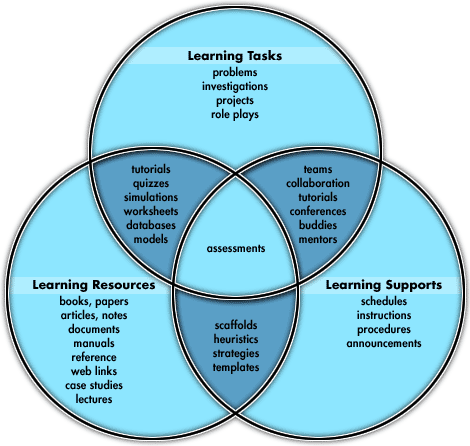| Following: An example, How to construct a sequence, An
early version
An Example of a Learning Design Sequence
The project evolved a graphical representation mechanism
to describe and document the generic learning design foci
in terms of the tasks, resources and supports that would be
required in the learning setting. This mechanism was later
applied to contextualised designs.
A 'Learning Design Sequence' representation uses the following
graphical notation:
- Squares represent Tasks.
- Triangles represent Resources.
- Circles represent Supports.
Here is an example describing one particular (contextualised)
learning design. (Note that POE = "Predict - Observe
- Explain"):
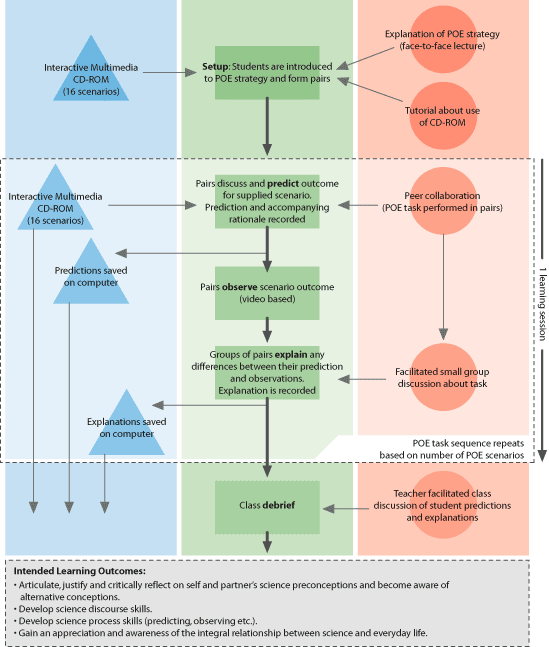
The project team considers the Learning Design Sequence construct
could be a form of documentation to serve as a "standard"/"common"
communication mechanism to explain and illustrate different
kinds of learning designs. Most generic guides and exemplar
descriptions housed within this website use the mechanism,
supported by additional documentation. This support typically
includes a description of key features of the learning design
and the nature of the tasks, resources and supports required.
The role of ICT in the implementation of the learning design
is also explained.
How to Construct a Learning Design Sequence
Note: This section is also available in .pdf format: How
to Construct a Learning Design Sequence (PDF).
Rationale
A protocol has been developed to illustrate a learning
design in a temporal format to provide a standard form of
communication to describe different kinds of learning designs
and highlight the key features of each design.
The basis for this construct is informed by the work of
Oliver (1999, 2001) and Oliver and Herrington (2001) that
identifies the critical elements required in a learning
design, particularly when ICT mediated. The critical elements
comprise the content or resources learners interact with,
the tasks or activities learners are required to perform,
and the support mechanisms provided to assist learners to
engage with the tasks and resources. This is illustrated
in Figure 1.
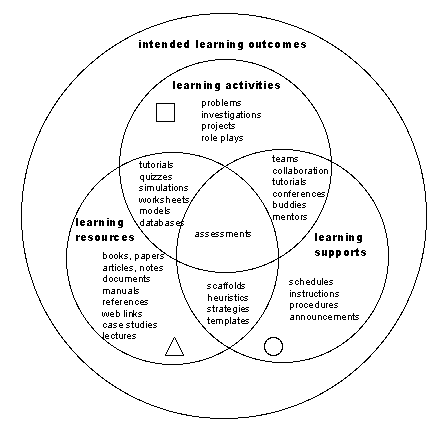
Figure 1: Components of a learning
design
Sequence representation of a learning design
The sequence of a learning design outlines the components
shown in Figure 1 as they are used over time. Thus, the
sequence illustrates the learning activities, the resources
and supports, plus the artefacts the students produce to
arrive at the final component of the sequence which is the
learning outcomes.
Representing learning activities: The learning
activities are represented by a series of rectangles, arranged
vertically. These activities represent the learnerís "journey".
Each rectangle has a description of what the learners are
required to do or produce. Activities that are assessable
are distinguished with an asterisk (*).
Representing learning resources: Learning
resources are represented by triangles to the left of the
activity sequence. An arrow from a resource (triangle) to
an activity (square) indicates that resources are available
to the student when doing the activity. An arrow from an
activity (square) to a resource (triangle) indicates that
a resource is produced during the activity and becomes a
resource for others to use later.
Representing learning supports: The learning
supports are represented by circles to the right of the
activity sequence. An arrow from a "circle" to a "square"
indicates that support strategies are being used to assist
the students in their learning.
Representing different combinations of activities,
resources and supports: Resources and supports can
be specific to an activity, they can be introduced before
beginning an activity or when an activity is complete, or
they may be available for the entire duration of the learning
experience. To represent this graphically, the following
convention is suggested:
- If learning resources or supports are limited to particular
activities, their availability is represented with a horizontal
arrow to the specific activity for which they are available.
- If a learning resource or support is available for multiple
activities then the resource triangle and/or support circle
is drawn once (where it is firstly introduced to the students)
and a vertical arrow indicates the resource and/or support
is available for period of time.
- If students produce artefacts from a learning activity
that are used as resources for subsequent activities,
an arrow is drawn from the activity to the resource.
An example illustration of a learning setting in a temporal
format is provided in Figure 2.
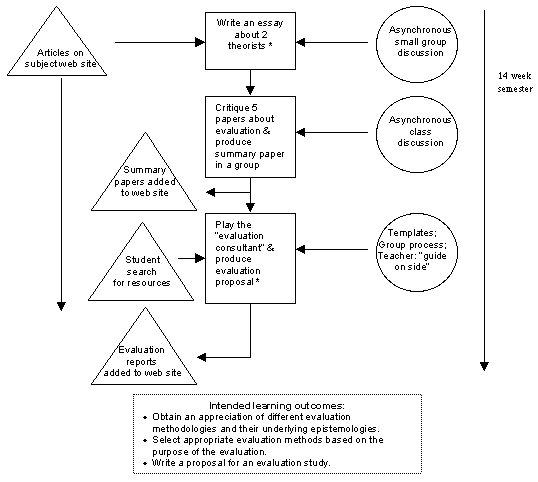
Figure 2: An illustration of a learning
design employed in a fictitious
Educational Technology subject about Evaluation methods.
Where the activities are different for different learners
or activities are concurrent, the activity sequence would
be represented by parallel activity components for that
section of the sequence. An example is illustrated in Figure
3.
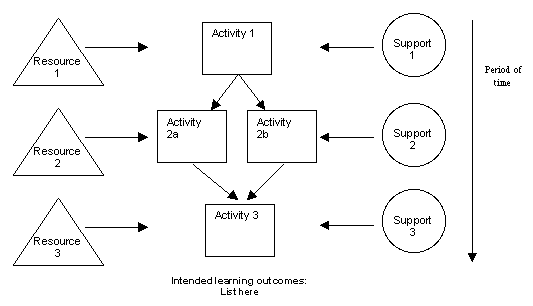
Figure 3: Example of concurrent activities
References
Oliver, R. (1999). Exploring strategies for on-line teaching
and learning. Distance Education, 20(2), 240-254.
Oliver, R. (2001). Seeking best practice in online learning:
Flexible Learning Toolboxes in the Australian VET sector.
Australian Journal of Educational Technology, 17(2),
204-222.
Oliver, R. & Herrington, J. (2001). Teaching and learning
online: A beginnerís guide to e-learning and e-teaching
in higher education. Edith Cowan University: Western
Australia.
|
